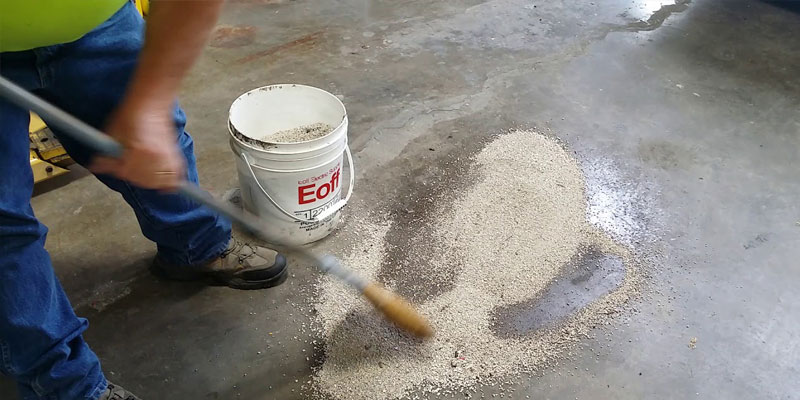Old Oil Stains on Garage Flooring: How to Fix Blemishes

The garage is one of the most used areas in any home. It’s a place where we store our cars, work on projects and generally just hang out. Unfortunately, it’s also a place where oil stains can happen.
If you’ve got old oil stains on your garage floor, don’t despair. There are a few things you can do to remove them.
In this article, we’ll cover the basics of oil stains on garage flooring and how to remove them.
Oil stains on garage flooring are not uncommon. In fact, they’re one of the most common types of stains that homeowners have to deal with. There are a few different ways that oil can get onto your floor, but the most common is from drips and leaks from your car.
If you’ve got old oil stains on your garage floor, there are a few things you can do to remove them. The first thing you’ll need to do is identify the type of stain. If the stain is fresh, you’ll have an easier time removing it than if it’s been there for a while.
Once you’ve identified the type of stain, you can start working on removal. For fresh stains, you’ll want to use a degreaser. You can find these at most hardware stores. Apply the degreaser to the stain and let it sit for a few minutes. Then, using a stiff brush, scrub the area until the stain is gone.
For older stains, you may need to use a stronger solvent. You can find these at your local hardware store as well. Be sure to read the labels carefully and follow the directions before using them on your floor.
Here are eight helpful tips for removing oil stains from your garage floor:
Table of Contents
1. Use a Degreaser for Fresh Stains.
One of the most crucial parts of oil stain removal is catching the stain early. As soon as the oil hits your floor, it begins to set in. The longer you wait, the harder it will be to remove.
That’s why it’s important to have a degreaser on hand for fresh stains. Degreasers are designed to break down oil and other tough messes. They’re available at most hardware stores.
To use a degreaser, simply apply it to the stain and let it sit for a few minutes. Then, use a stiff brush to scrub the area until the stain is gone.
2. Use Solvents for Older Stains.
If you’re dealing with an older stain, you may need to resort to using a solvent. Solvents are stronger than degreasers and can be found at your local hardware store.
Before using a solvent, be sure to read the label carefully. Some solvents are highly flammable, so it’s important to use them safely.
Once you’ve chosen a solvent, apply it to the stain and let it sit for a few minutes. Then, use a stiff brush to scrub the area until the stain is gone.
3. Use Vinegar for Stubborn Stains.
If you’re dealing with a stubborn stain, vinegar may be your best bet. Vinegar is an acidic substance that can break down even the most stubborn stains.
Thankfully, vinegar is also a natural substance, so it’s safe to use around your home.
4. Use Baking Soda for Tough Stains.
Baking soda is another common household item that can be used to remove oil stains. Baking soda is a mild abrasive that can break down tough stains.
The best way to use baking soda is to make a paste. To do this, simply mix baking soda with water until it forms a thick paste. Then, apply the paste to the stain and let it sit for a few minutes. Finally, use a stiff brush to scrub the area until the stain is gone.
5. Use Ammonia for Set-In Stains.
If you’re dealing with a set-in stain, ammonia may be your best bet. Ammonia is a strong chemical that can break down even the most stubborn stains.
However, ammonia is also a toxic substance, so it’s important to use it safely. Be sure to open windows and doors when using ammonia and always follow the directions on the label.
6. Use WD-40 for Dried Stains.
If you’re dealing with a dried stain, WD-40 can be your best friend. WD-40 is a lubricant that can break down even the most stubborn stains.
To use WD-40, simply spray it on the stain and let it sit for a few minutes. Then, use a stiff brush to scrub the area until the stain is gone.
7. Use Lemon Juice for Fresh Stains.
Lemon juice is another common household item that can be used to remove oil stains. Lemon juice is an acidic substance that can break down fresh stains.
Always test lemon juice on a small area before using it on the entire stain. Some flooring materials may be damaged by lemon juice.
8. Use Cornstarch for Dried Stains.
Cornstarch is another common household item that can be used to remove oil stains. Cornstarch is an absorbent substance that can soak up dried stains.
This method is best used for small stains. Simply sprinkle cornstarch on the stain and let it sit for a few minutes. Then, use a vacuum to remove the cornstarch.
Old oil stains on garage floors can be difficult to remove. However, with the right products and techniques, you can get rid of them quickly and easily. Be sure to follow these tips next time you’re dealing with an oil stain on your garage floor.
